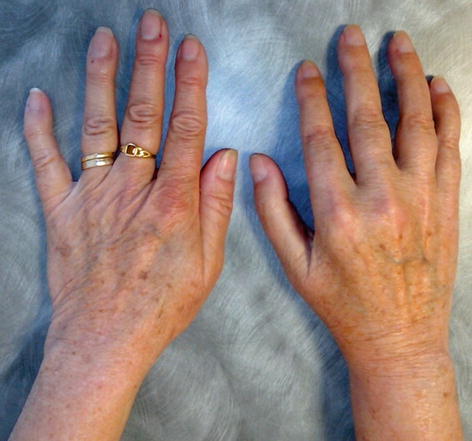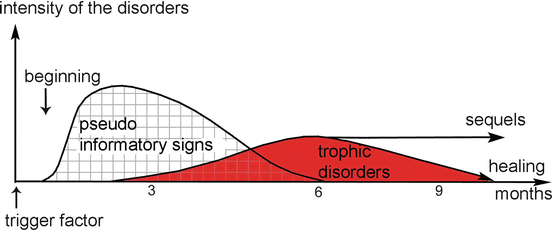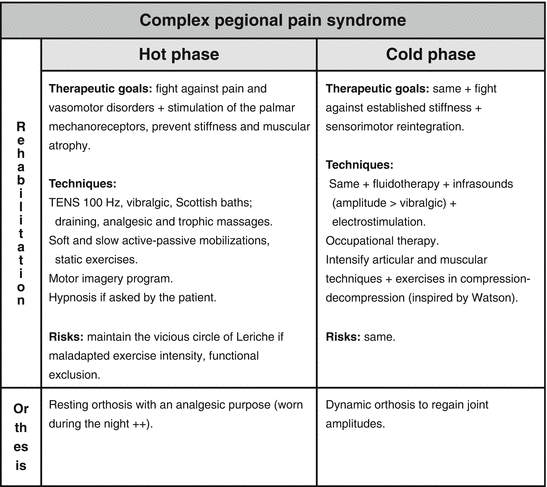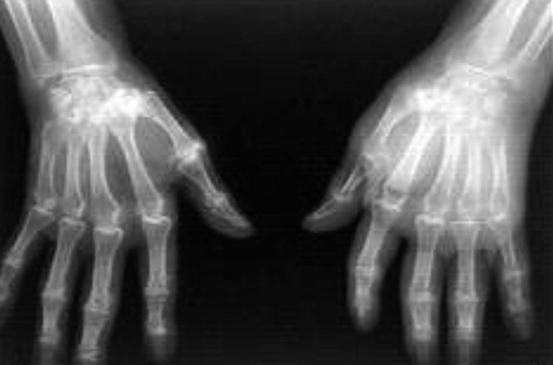17.4 Diagnosis and Clinical Signs
The diagnosis is clinical and must be established early to rapidly set up a treatment. However, it’s difficult to diagnose as there are some atypical and late forms.
The pain is described as severe, constant, burning, and disproportionate in relation to the traumatic event or secondary to a surgery. It can be present in several extremities with sometimes allodynia and/or hyperpathia.
Cutaneous modifications can also be observed: the skin seems shinier, dry, and even scaly. The nails become brittle, and the hairs on the damaged extremity are thicker. Either the sweat increases or the skin gets colder. The skin can also change color, from white to red with blue spots (because of the thermic changes) (Fig. 17.1).


Fig. 17.1
Right hand with CRPS
There’s an edema in the painful area. It can be soft, leaving a depression when we press on the area (venous edema), or hard (lymphatic edema).
There’s also limitation of the movements with onset of dystonia, joint stiffness, tremor, or involuntary shaking, as well as coordination disorders.
Complementary exams can be realized to confirm the diagnosis:
17.5 Evolution
The evolution of the CRPS changes from one person to the other but usually spreads from 12 to 48 months. There are three evolution stages, and the apparition of the symptoms can stretch out over several months. Some patients don’t reach the third stage (Schema 17.2).


Schema 17.2
Evolution of the CRPS
17.5.1 Stage 1 (Hot or Acute Phase)
It can last for 6 months and is associated with the apparition of spontaneous pain, disproportionate in relation with the trauma. This pain is limited to the wound area. Simple cutaneous pressures can cause pain (hyperesthesia). There’s a localized edema. The skin becomes shiny with hyperhidrosis (increased sweating). Redness and hotness are frequent because the regional neurovegetative system is disturbed. The joint mobility is limited, which causes a functional discomfort for the patient.
17.5.2 Stage 2 (Cold or Dystrophic Phase)
The cold phase lasts 3 to 12 months. During this phase the skin can have a bluish color, with a local decrease of the temperature. The spontaneous pains progressively decrease but stay important when mobilizing. The fingers are sharp with brittle and stripped nails. The edema tends to decrease but becomes hard with tissue fibrosis that will cause joint discomfort. Muscular atrophy is frequent, and it’s during this phase that fibrosis adherences settle, leading to functional limitations. We can then observe a “claw” deformity.
In this stage, radiography allows observing a demineralization with disappearance of the bone material [6].
The patient evolves towards recovery or towards sequelae.
17.5.3 Stage 3 (Sequelae Phase)
During this phase that lasts from 6 to 24 months, the main symptom is a joint and tendinous stiffness that can be irreversible. This evolution justifies an early treatment of the CRPS, combining an analgesic treatment with a multidisciplinary rehabilitation.
17.6 Therapeutic Process
The early diagnosis of the CRPS leads to the development of a specific treatment. The main drugs found in this pathology are corticoids (infiltration), calcitonin (analgesic and vasoactive effect), and type I analgesics (during rehabilitation). Bisphosphate is also used as it fights against osseous demineralization, as well as sympatholytics that inhibit the adrenergic receptors α and β.
Rehabilitation should start the earlier possible to avoid the beginning of the vicious circle and decrease the risk of functional sequelae. However, some principles must be respected, like working under the pain threshold and mobilizing to avoid possible adherences and retractions, decrease the edema, and avoid the functional exclusion of the damaged limb.
The relational aspect is also very important in a pain syndrome. It is essential for the multidisciplinary team to establish a relationship of trust with the patient.
17.7 Rehabilitation and Orthotic Treatment (Fig. 17.3: Protocol)

Fig. 17.3
Rehabilitation protocol
17.7.1 Hot Phase
The priorities are treating pain and fighting against trophic disorders and stiffness.
For that, we use:
17.7.1.1 Physiotherapy
Scottish Baths
We obtain an analgesic and trophic effect. We put the hand in hot water for 4 min, then 1 min in cold water. We repeat this process four times and end with cold water (total duration: 20 min).
Stay updated, free articles. Join our Telegram channel

Full access? Get Clinical Tree









